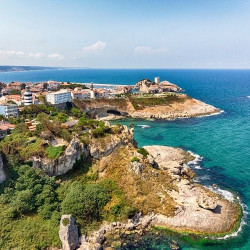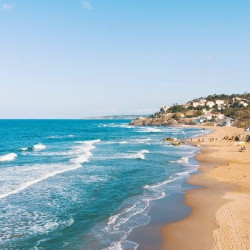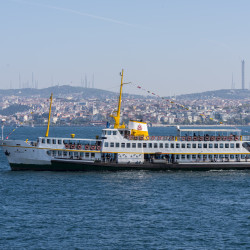Iznik fills our lungs with oxygen and our minds with peace. Even when you set off from Istanbul by ferry from Yenikapı or Pendik, you have the beautiful Prince's Islands beside you, and you get to the Yalova Pier, which you arrive at 1 hour later, you see the gorgeous Iznik Lake immediately. This district, which you can easily visit in a single day, has a peaceful nature. Iznik, a quiet little town away from the eyes, remains very modest compared to its huge historical background. Iznik, which has been preserved for centuries with its city walls stretching for 5 km, is both the first Turkish capital in Anatolia and one of the few cities considered sacred for Christianity, by the Vatican.
How to get to Iznik?
Iznik is located in the south of Istanbul and northwest of the city of Bursa. If you are going to set off from Istanbul, the best option would be a 1-hour sea voyage with the ferries departing from Yenikapı or Pendik. It will take two hours if you go by car.
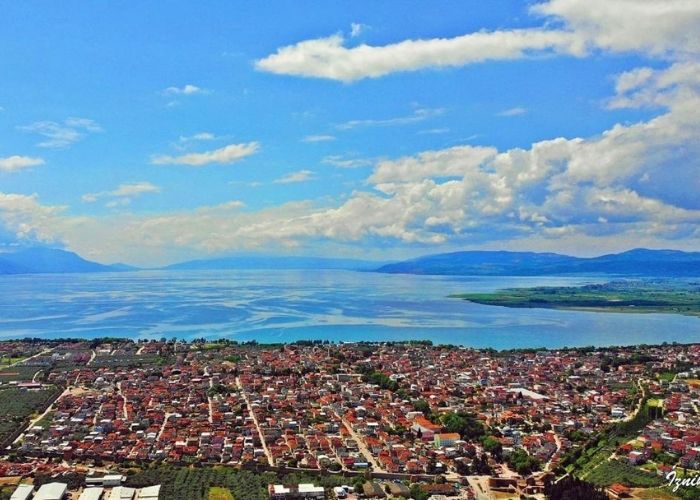
What to Eat in Iznik?
The famous tastes of Iznik are fish soup, skewers, scratch (fried yellow fish), crayfish, and olives. You can enjoy spending time in close contact with nature in the seafood restaurants and cafes in Bursa's Iznik Districts. These establishments, which are typically on the coast of Iznik Lake, allow you to taste Iznik Lake fish while sipping tea or Turkish coffee and taking in one of the most breathtaking sunsets in the world. Restaurants serve Iznik Lake fish, which you may also try. You can also sample the Iznik-produced table olives.
History and Legends of Iznik
Iznik, a Hellenistic, Roman, Byzantine, and Ottoman settlement, is almost an open-air museum. Because the monumental structures bearing traces of all these civilizations, especially the city walls, are still standing. BC in Iznik we know today, there was a settled life even before the 7th century. The settlement called Helikore was home to the Thracian tribes in the 7th century BC. In 316 BC, the city was renovated by Antigonos, one of the generals of Alexander the Great, the Macedonian Emperor, and its name is Antigoneia after Antigonos. However, after the death of Alexander, during the war between General Antigonos and another man of Alexander, General Lysimakhos, the city fell into the hands of Lysimakhos and he gave the city the name of his wife Nicaea. Nicaea was connected to the Kingdom of Bithynia in 293 BC and became one of the classical cities of Rome.
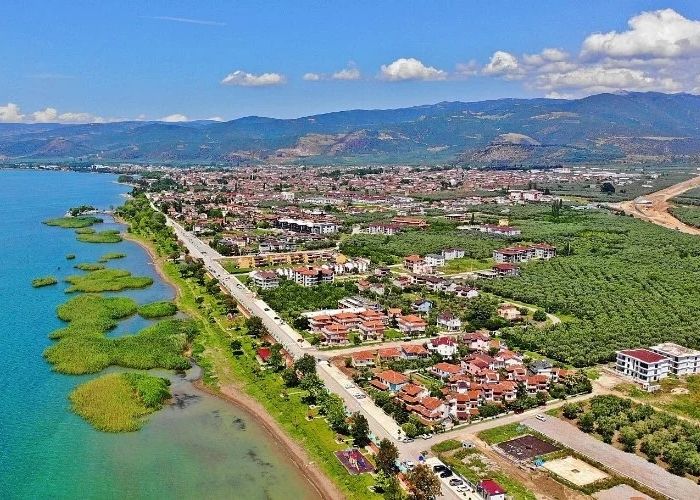
Nicaea is the place where the first ecumenical (universal) Christian council met. With the decision taken as a result of this meeting, the belief that Jesus is the son of God, which continues to be valid even today, becomes general. In the 19th council convened in the Vatican in 1962, it was declared the third holy city in the world after Jerusalem and the Vatican, the Pope.
Nicaea, which remained under Byzantine rule until the Seljuks, became the capital of the Seljuk State after the conquest of the city by Kutalmışoğlu Süleyman Shah. Kutalmışoğlu Süleyman Şah changes the name of the city to “İznik” which means “Trace of Nicaea” in Turkish.
Iznik, which hosted the first madrasah and soup kitchen of the Ottoman Empire, was built between the 14th and 16th centuries. In the 19th century, it became an important education, culture, art, and trade center where many scientists and artists were trained. The most famous educators of the empire gave lectures in the madrasahs here. The city, which lived its golden age, especially during the reign of Murat II and the Çandarlılar, became an important accommodation center as it was on the caravan route from Istanbul to Anatolia. After the conquest of Istanbul, the importance of Iznik began to decline, with Istanbul gradually gaining importance and subsequent migration of the prominent families of Iznik to the West.
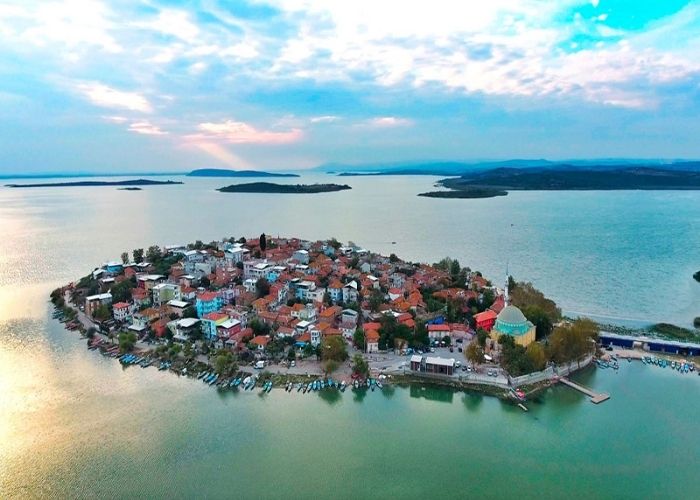
The belief that an Atlantis-like buried city lies under the waters of Lake Iznik is the most famous legend of Iznik. For centuries, there have been rumors among the fishermen of Iznik that nets and fishing rods were caught on the minarets of the sunken city. In the lake, which was declared a Protected Site in 1990, research made in recent years has shown that this may be much more than a legend. The discovery of the basilica, which was found underwater in 2014 has been the most concrete evidence to date for the claims that there is indeed a sunken city in Lake Iznik.
Historic City Walls and City Gates
The exact date of the city walls of Iznik with a height of 10-13 meters and a total length of 4,970 meters can not be determined, yet it can be said that they are generally recorded as dating from the Late Roman Period. The grid city plan in Iznik is proof that the city dates back to the Hellenistic Age, but the walls are not from that period. Due to earthquakes and wars, the walls were repaired in many different periods. Among the 5 main gates of the city, the Lefke Gate (east) and the Istanbul Gate (north) are the two most important surviving gates. Similar features are seen on both doors. Inscriptions were written in Ancient Greek, and various scenes from Greek Mythology and the Roman triumphal arch form stand out on both doors. That is because the stones removed from the ancient theater were used in the construction of the walls due to the need for materials to repair the walls damaged in the wars. It was believed that the masks resembling Medusa at the Istanbul Gate protected the city from evil spirits.
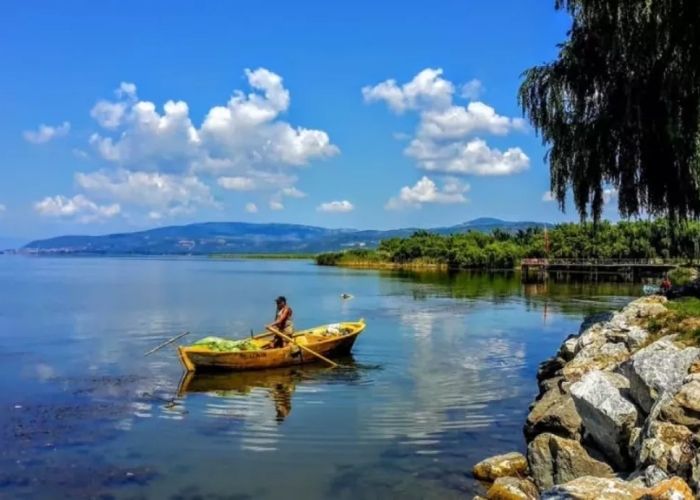
Green Mosque
We can say that the beautiful tiled Green Mosque of Iznik is the symbol of Iznik. The mosque draws attention with its stonework on the marble altar, which is the first example in the Ottoman Empire, and most importantly with its minaret decorated with turquoise, green and purple tiles. This mosque was not alone but was in the form of a complex with its bath and madrasah. Unfortunately, the other structures of the complex (külliye) have not survived.
Iznik Hagia Sophia Mosque
Iznik Hagia Sophia Mosque is the most famous structure in Iznik. This is the church where the 7th Christian Council was held in 787, but Orhan Gazi converted the bell tower into a minaret after 1331 and turned it into a mosque.
Dikilitaş (The Obelisk)
The Obelisk, or Beştaş, is a 12-meter-high monument erected in the name of C. Cassius Philiscus in Iznik, dating from the Roman period, in the 1st century AD. Another name for it is “Beştaş” (five stones) because it is made of five stones in a row. It has Greek inscriptions on it. The 6th stone on the top has not survived to date. That 6th stone is thought to be a featured figure such as the goddess of victory or an eagle statue. It is located within the borders of Elbeyli Village, 7 kilometers from the center of Iznik. It is easy to reach there by renting a bicycle.
Suleyman Pasha Madrasa
This is the Süleyman Paşa Medresesi, known as the first Ottoman Madrasa. The first madrasa of the Ottoman Empire was the Iznik Madrasa, which was called the Manastır Madrasa (1331), but unfortunately, that madrasa has not survived. The exact location of it is also not known today. The madrasa, built in 1332, is a madrasa built by Prince Suleiman, the eldest son of Orhan Gazi, known as the "Conqueror of Rumelia''. It reflects the original character of early Ottoman architecture. Now the madrasa has turned into a bazaar where there are tile workshops.
Haci Ozbek Mosque
The Hacı Özbek Mosque built between 1333 and 1334, is considered the first mosque of the Ottoman Empire. Because the oldest of the mosques with an inscription, that is, a written construction date, is the Hacı Özbek Mosque. It has a small, square plan, and a mixed stone and brick architecture. Many additions and adjustments were made to the structure.
obelisk
Tile Workshops
Iznik today is most famous for its tile art. Tile art is a handicraft that dates back to Anatolian Chiefdoms and Seljuks, but lived its golden age with the Ottomans. It is an art consisting of a combination of various techniques, in which the soil is shaped and colored before it enters the kiln, and then mostly used as wall covering and decorative material in architectural structures or for covering daily use items such as pots, plates, vases, and jugs. There are dozens of tile-making techniques derived from the knowledge accumulated from Ancient Greece to the Seljuks, and Iznik is a magnificent place to see them. Some workshops here still keep this historical and valuable art alive and offer visitors the opportunity to experience tile-making in one day. At Adil Can Nursan Art Workshop, you can observe tile styles from 13 different periods, watch the tile production, and try it yourself. Another famous tile workshop is Eşref Eroğlu Art Workshop. Apart from these two workshops, there are many workshops as well.
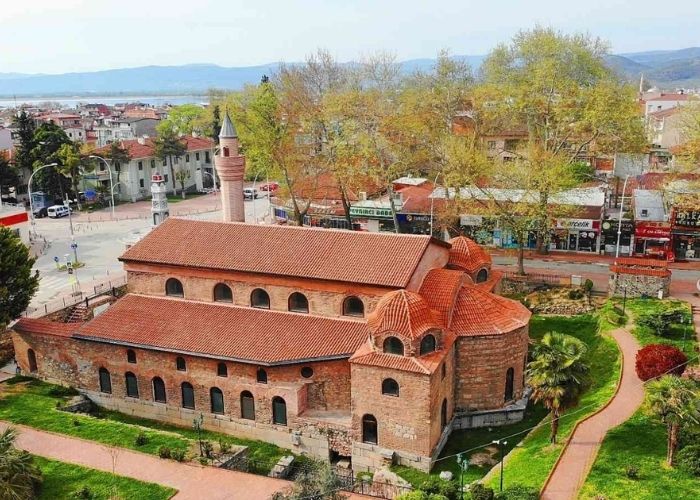
650 years old Turkish Bath
The Bath of Murat I, or Hacı Hamza Bath, is one of the baths that have been restored and reopened recently. The historical bath from the 15th century is about 650 years old today.
Lake Iznik
Lake Iznik is the largest lake in the Marmara region and the 5th largest lake in Turkey. The lost city mentioned in the legends is said to be under this lake, and the basilica, which was unearthed in 2014, can be easily seen on days when the weather is beautiful and the water is clear. You can travel with your canoe over this lost city in Lake Iznik, which is a natural wonder. You can also eat freshwater fish such as carp, trout, and catfish living in the lake at the restaurants nearby.
Iznik Port
If you want to watch the sunset from the land, you can sit in the tea gardens at the Iznik quay, where you can have tea and coffee, against the view of the fishing boats and the lighthouse.
Olive Gardens
The people of Iznik say that the best black olives are made here. When you come here, you may consider buying its delicious olives or olive oils.
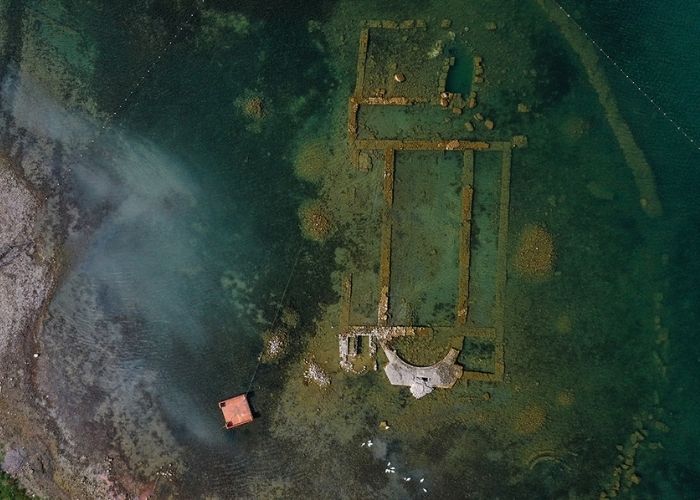
Sansarak Canyon
Another hidden gem of Iznik is Sansarak Canyon. This is also a great place for hiking and swimming afterward. Located in the Sansarak Village of Iznik, the canyon is a canyon in the forest with a 7-kilometer-long swimming pool in summer and a 1.7-kilometer medium-level track that is not easy. Sansarak Village, through which the canyon passes, is a 500-year-old Ottoman village. While passing through this village, do not continue on your way without drinking tea traditionally cooked on a wood fire.
Keramet Ilıcası
Keramet Ilıcası (springwater) is connected to the Orhangazi district, but it is also 25 kilometers and 30 minutes away from Iznik, so it is very close. Its sulfuric water is said to be medicinal.
A Day Trip to Remember: Explore the Hidden Gem of Bursa with Istanbul.com
With Istanbul.com, you can take a day trip to Bursa and discover its rich history, beautiful architecture, and natural wonders. Istanbul.com there are day trips that offer a convenient and affordable way to visit Bursa, with transportation, guided tours, and entrance fees included. Book your Bursa day trip with Istanbul.com now and discover the beauty of this enchanting city.
Discover more outdoor experiences with Istanbul.com
If you're looking to make the most of your trip to Istanbul, and seeking an unforgettable outdoor experience, the Sapanca Lake and Maşukiye Daily Tour is a must-see. Immerse yourself in the stunning natural beauty of the region with this breathtaking journey through scenic landscapes. And if you're a thrill-seeker, don't miss Xtrem Adventures Istanbul - a high ropes park with zip-lining and other adrenaline-pumping activities. By purchasing your attractions through Istanbul Tourist Pass®, you'll not only save time and money but also gain exclusive access to additional discounts and benefits. So don't wait - book your adventure today and make unforgettable memories in Istanbul!
 English
English  Indonesian
Indonesian  Urdu
Urdu  Taiwanese
Taiwanese  Russian
Russian  Romanian
Romanian  Portuguese
Portuguese  Persian
Persian  Macedonian
Macedonian  Korean
Korean  Japanese
Japanese  Italian
Italian  Indian
Indian  Hungarian
Hungarian  Greek
Greek  German
German  Croatian
Croatian  Chinese
Chinese  Bulgarian
Bulgarian  Arabic
Arabic  French
French  Spanish
Spanish 






